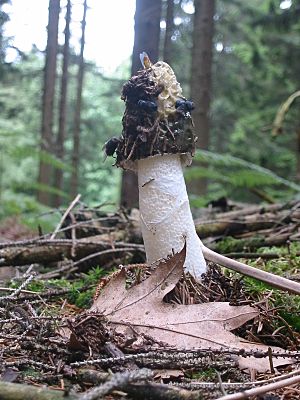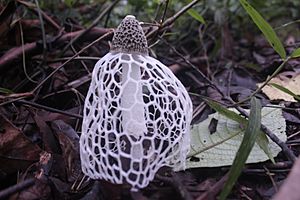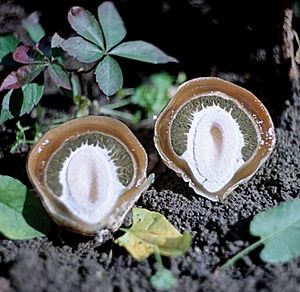Phallaceae facts for kids
Quick facts for kids Phallaceae |
|
|---|---|
 |
|
| The common stinkhorn | |
| Scientific classification |
|
| Kingdom: | Fungi |
| Division: | Basidiomycota |
| Class: | Agaricomycetes |
| Order: | Phallales |
| Family: | Phallaceae Corda (1842) |
| Synonyms | |
|
Clathraceae Chevall. 1826 |
|
Phallaceae is a family of fungi, commonly known as stinkhorns. These interesting mushrooms are found all over the world, especially in tropical areas. They are famous for their very bad smell, which comes from a sticky, gooey part called the gleba. This gleba holds the mushroom's spores.
The gleba sits on top of a stalk, which is called the receptaculum. This unique shape helps tell stinkhorns apart from other fungi. The smell of the gleba is often like rotten meat or animal waste. This strong smell attracts flies, beetles, and other insects. These insects then help spread the spores to new places.
Even though stinkhorns can look very different, they all start as oval or round "eggs" hidden underground. Stinkhorns can grow incredibly fast. The gleba can pop out of the underground egg and open up in less than an hour! In 2008, scientists estimated there were 21 different groups (genera) and 77 types (species) of stinkhorns.
Contents
What Stinkhorns Look Like
Stinkhorn mushrooms have spores that grow inside them. Their fruit bodies begin as a jelly-like, round, or egg-shaped structure. This "egg" might be completely or partly buried in the ground. The outer layer of the egg, called the peridium, can be white, purple, or red. It has two or three layers. The outside layer is thin and stretchy, while the inside layer is thicker and jelly-like.
When the mushroom is ready, the peridium opens up. It then stays as a cup-like base at the bottom of the stalk.
How Stinkhorns Grow
The stinkhorn mushroom is one of the fastest-growing mushrooms in the world. It can grow as much as 5 millimeters every minute! It grows so quickly that you might even hear a crackling sound. It doesn't actually "grow" in the usual way. Instead, it uses a special method, like cellular origami, to quickly get bigger by soaking up water.
The part of the mushroom that holds the spores often sits on top of a wide, soft stalk. This stalk can be shaped like a cylinder, a star, or even a net. Stinkhorns can be very brightly colored. Some even have a net-like or veil-like membrane that covers and protects the spores.
The sticky, spore-filled substance, the gleba, is usually jelly-like and often smells terrible. It can also become liquid as it soaks up water. The gleba forms on the outside of the mushroom's cap or on the upper part of its stalk.
Stinkhorn Chemistry
The jelly-like layer of some stinkhorns, like the Clathrus ruber, has a lot of potassium, calcium, manganese, and iron. The stalk and gleba also contain some calcium and a lot of manganese.
Having a lot of potassium helps the stalk of the mushroom grow. Potassium is important for controlling the water pressure inside the stalk, which helps it keep its shape. The calcium in the jelly layer makes it slimy. This sliminess protects the stalk as it grows. This sticky, jelly-like layer is made of special sugars called polysaccharides.
The high amounts of manganese and iron in the jelly layer and gleba might help create enzymes. These enzymes could produce sugars and the smelly compounds that attract insects.
Can You Eat Stinkhorns?
Yes, stinkhorns can be eaten! But only when they are still in their "egg" stage, before they start to smell strongly. The inner layer of the egg can be cut out with a knife and eaten raw. It is said to be crisp and crunchy, with a taste similar to a radish.
These mushrooms also contain some special compounds. Scientists are studying these compounds to see if they could be used to help treat cancer.
Stinkhorn Types
Here are a few examples of stinkhorn groups:
- Blumenavia (named by Möller in 1895)
- Colus (named by Cavalier & Séchier in 1835): This group has four types of mushrooms. Their fruit bodies have a short stalk with six columns that join at the top. This forms a red, net-like structure. The sticky gleba is spread on the inside of this net.
- Pseudoclathrus (named by B. Liu & Y.S. Bau in 1980)
Why Stinkhorns Smell Bad
The number and types of smelly compounds that stinkhorn mushrooms produce change as they grow. When a stinkhorn is still in its "egg" stage, it doesn't have many smelly substances. The strong, sulfur-smelling compounds that attract insects are not there yet. At this stage, a veil covers the slimy, spore-filled cap.
When the stinkhorn grows into a more mature mushroom, it produces over twenty-two different smelly compounds. These include sulfur compounds, special phenylalanine compounds, and various terpenoids. All of these act like a magnet for insects.
An over-ripe stinkhorn can have forty-one different smelly parts. Many of these also attract insects. The sulfur compounds are less common in over-ripe mushrooms because insects have already carried much of the smelly slime away.
The stinkhorn's smell contains compounds found in rotten meat, like oligosulfides. It also has compounds found in animal waste, such as phenol and indole. This shows that the stinkhorn is mimicking these bad smells. It uses them to trick flies into thinking it's a good place to find food or lay eggs. The flies are drawn in by their natural attraction to the smell of decaying animal matter that the stinkhorn gives off.
|
See also
 In Spanish: Phallaceae para niños
In Spanish: Phallaceae para niños




